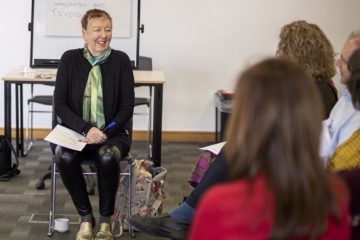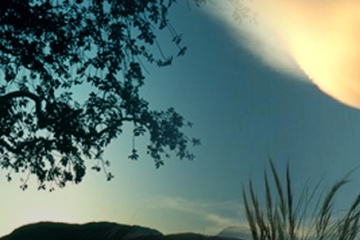The somatic path of coaching – working with body-mind and being
On a recent coaching course workshop, one of our students shared with surprise, their realisation that they had been engaging in personal development for many years through the lens or filter of their survival self, rather than their healthy or authentic self. At the time, I thought this was an interesting observation and left it at that. At some point the next day, my unconscious having worked busily away, something troubling dawned upon me – that I had been doing exactly the same, for nearly forty years. In my case, my survival self is my mind orientation and the way I seek external acknowledgement and internal control through understanding and intellectualisation. That’s not to say that I haven’t experienced much of my lifetime of personal development authentically, but that my pattern is to split and intellectualise. On realising this, I experienced a profound shift, which felt like a descent into my body from my head, or into my being from my mind, and for the rest of the weekend I experienced resting in this new way of being. I felt grounded and present, at the same time able to access and engage my mind, but without detaching from my emotions or felt sense. I found it helped to place my hands on my chest or stomach and to acknowledge my felt senses in other ways, when later sharing this experience with the group.
In the above story, I am referencing a model of the personality by professor Franz Rupert, which is explained in a really excellent paper on “What has trauma got to do with coaching? Or coaching got to do with trauma?” by Julia Vaughan Smith. I first saw this published as an APECS symposium paper but you can also find this on her website here. The model shows how splits in the personality and identity structure after a traumatic experience give rise to three parts of ourselves (healthy, traumatised, survival) and Julia explores how to work with these in coaching.
She explains how trauma is held in the body and points towards related developments in somatic coaching which I will discuss below. She concludes “it is my view that coaches with understanding and experience of this field (personality and self) can bring something additional to the coaching work, a greater transitional space between the inner and outer worlds, which allows for deep transformation without working directly with the traumatised self or with the past. It needs a slightly different tool kit…”. Julia is answering better than I have seen anywhere else the question about the boundary between coaching and therapy here, and also describing the work that we do on our psychosynthesis coaching courses very well.
Somatic coaching is an emerging approach within the coaching profession and I want to use this post to provide an overview to anyone new to this perspective. In his very readable book on The Art of Somatic Coaching Richard Strozzi-Heckler sets out the central premise of somatic work, that “…while psychotherapy focused on reasons why something is the way it is, I would ask how is it that we have formed ourselves. For example, how do we form ourselves toward contact or away from contact, instead of Why don’t we make contact?”. In this seminal work, Strozzi-Heckler issues a call to those interested in personal and societal evolution to wake up. He sets his somatic approach within historical, coaching and personal contexts and makes some basic distinctions between the entry points of working on, with and through the body. The book goes on to describe a methodology for somatic coaching, the importance of attending to our rhythm of energy and ends with mapping out the somatic arc of transformation. Below is my take on these key pieces and some suggested questions for somatic coaching…
- Entry points for somatic practice…
- Working on the body – addressing presenting symptoms physically or by touch, usually by someone trained in a relevant professional modality, e.g. massage, reiki, kinesiology, craniosacral therapy, osteopathy, physiotherapy, etc.
- Working with the body – to release blocks by working physically, energetically, emotionally, relationally, etc.
- Working through the body – engaging life energy by attending to what is, what has been, what is emergent and the call of the Self…
- Methodology of somatic practice
- Somatic awareness – becoming aware of our sensations, to feel, to notice…
- Somatic opening – opening of the soma so change can occur, undoing the habitual shape to allow another shape to come to life
- Somatic practices – e.g. breath, movement, visualisation, enabling us to embody new skills and ways of being to support our goals and our emergent self
- Rhythm of energy (with the gestalt cycle of experience equivalent)
- Awakening – sensation and awareness
- Increasing – mobilisation of energy and action
- Containing – contact and resolution
- Completing – withdrawal and completion
- Somatic arc of transformation (and related psychological orientations)
- Historical shape – the prepersonal and the past
- Unbounded shape – the personal and the present
- New shape – the transpersonal and the emergent future
Some somatic coaching questions I use…
- What is going on for you now? What sensations, or feelings in your body?
- What’s that feeling? Where do you feel that in your body? Maybe place your hand there…
- Do you notice your posture (or shape) as you say that? What might your posture be saying?
- Can you breathe into that place – what is that like?
- Would it help to take a deep breath? – maybe take a few, slow deep breaths (and breathe with them)
- As you step into that space or place, what do you want to say? What is your felt sense?
- As you step out of that space or place, what do you notice or become aware of?
In Embodying Authenticity, Eunice Aquilina (a student of Strozzi-Heckler) adds depth and breadth to the somatic narrative in a very personal and practical account that is richly illustrated with stories of how she works with leaders and organisations (yes, this stuff is practical!). She also goes some way to weaving the somatic perspective together with other important perspectives informing leadership and coaching such as the developmental prism (e.g. Laloux, Kegan, Cook-Greuter, Torbert), complexity theory and systemic practice (e.g. Critchley, Wheatley, Stacey and Shaw), amongst others.
Eunice speaks of the need for ‘wise and conscious leaders and practitioners, who are able to tune into themselves and simultaneously tune into what is emerging in the field, taking action from a deeper sense of awareness’, and views organisation as living systems where ‘leaders can bring their whole selves as fully rounded human beings and invite others to do the same… this is the offer of somatics’ (and a response to my piece on The Leadership Gap). This is also very much the territory of engaging with Laloux’s principle of wholeness in evolutionary (or Teal), organisations. She challenges the reader to engage in an inquiry of how their ‘history literally shapes what has become habitual ways of being’. She shows how to work with the somatic arc of transformation to ‘shape a new way of being in the world’. She explores how we can use the ‘self as instrument’ of change, and how through the quality of our presence, we create a strong container for others where we cultivate trust and listen beyond words…”.
This somatic approach refers to the self as the source of our energy, wisdom and insight and in many ways this is entirely congruent with psychosynthesis. However, in my view, this work needs to be underpinned for coaches by drawing upon a robust psychology of self and will (such as psychosynthesis), and a therapeutic awareness of how the different parts of ourselves come into play, such as discussed in Julia Vaughan Smith’s paper and explored on her retreats. If not, the somatic practitioner is in danger of waking up parts or releasing energies within their clients, which they don’t know how to deal with. We are noticing coaches coming towards psychosynthesis coaching because they are finding clients opening-up to them and engaging at an emotional level which they don’t feel fully equipped to deal with. They are looking for a stronger context for working at greater depth and height without necessarily becoming a therapist.
Just as it has become less taboo to refer to and work with feelings in organisations (thanks in part to the popularisation of EQ), so too now with the body and it feels much easier to refer to it within the coaching context, than say twenty years ago. Somatic working doesn’t necessarily involve touch and you will probably stay away from direct physical contact unless you are explicitly combining coaching with some other touch based modality. Somatic working can involve engaging with human form and energy in a host of ways, including posture, shape, pattern, flow, space, rhythm, movement, stillness and breath.
I must emphasise that I have not been specifically trained in the somatic approach, however, I find it both immediately relevant and intuitively accessible as another dimension to the way that I work, whether as coach, facilitator or educator. There is a natural fit within the context of psychosynthesis psychology and the model of Body-Feelings-Mind. Roberto Assagioli explored the deeper processes of involution and evolution and emphasised the need for human beings to work towards full embodiment as well as self-realisation – in other words we need to both come more into our bodies, anchoring in the physical plane and connected to the earth, as well to discover our higher nature and transcend our material fixations. Embodiment, incarnation (e.g. the journey from spirit to matter) and becoming grounded, doesn’t end with being born and is something we might work on our whole lives, as part of coming more into our being and presence (as I described in my story at the beginning). In other words, connecting-down as well as up, and somatic working really helps with this. I suspect this is particularly important in modern western society where cultural splits between mind and body have become endemic and where many of us are over mind-identified (thinking is all). This may all sound a bit esoteric, but I find people referring to this need all the time in my coaching practice – I want to be more grounded and fully present… I just need space to breathe… this may sound crazy, but I feel like I’m still working towards becoming embodied…
There seems to be a paradox at the heart of this somatic path, which is held by the dual meaning of somatic – sometimes meaning of the body, but also more essentially meaning of the body-mind (as an indivisible whole). Much of the practice involves working through, with or on the body as the entry point, but staying mindful that in doing this we are engaging with the whole human being, mind-body-feelings, and activating all levels of consciousness.
For an insight into how somatic practice works in practice, two APECS colleagues, Fiona Adamson and Elspeth Campbell, are running a short session to demonstrate somatic coaching at this years’ APECS Symposium (see more below):
Coaching-with-the-body, our felt sense of awareness, is becoming increasingly accepted as part of coaching practice. Instead of asking why something is the way it is, we explore how it is that our sensory perceptions and emotional responses have contributed to patterns of behaviour in interactions, and formed ways of being.
There is one other very significant way in which the somatic perspective has informed a change in the way I work as a coach, which is how I approach mindset change, both at the individual and organisational level. This will be the subject of my next post to follow shortly, because there is too much to include here.
In the meantime, let me encourage you to take a closer look at the 2017 APECS Symposium (June 7th at Phyllis Court Henley); although primarily a forum for our members, we also welcome guests and have allocated 20 tickets to non-members. We have a fantastic range of 24 sessions to choose from, under the overall theme of ‘How can coaching best respond to the emerging challenges of leadership?’
Programme details and booking link is here: https://apecsevents.wordpress.com/2017/03/25/revealing-the-full-agenda-for-the-2017-apecs-symposium/
Thanks for reading
Aubyn



